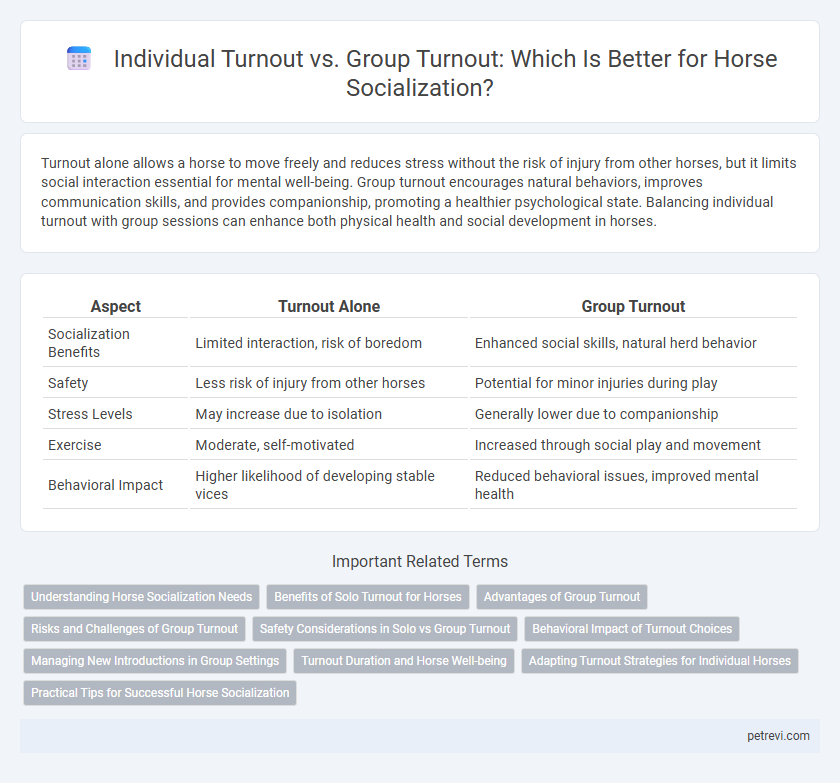Turnout alone allows a horse to move freely and reduces stress without the risk of injury from other horses, but it limits social interaction essential for mental well-being. Group turnout encourages natural behaviors, improves communication skills, and provides companionship, promoting a healthier psychological state. Balancing individual turnout with group sessions can enhance both physical health and social development in horses.
Table of Comparison
| Aspect | Turnout Alone | Group Turnout |
|---|---|---|
| Socialization Benefits | Limited interaction, risk of boredom | Enhanced social skills, natural herd behavior |
| Safety | Less risk of injury from other horses | Potential for minor injuries during play |
| Stress Levels | May increase due to isolation | Generally lower due to companionship |
| Exercise | Moderate, self-motivated | Increased through social play and movement |
| Behavioral Impact | Higher likelihood of developing stable vices | Reduced behavioral issues, improved mental health |
Understanding Horse Socialization Needs
Horses are inherently social animals that benefit significantly from group turnout, which allows natural herd interactions, promoting mental well-being and reducing stress-related behaviors such as cribbing or weaving. Solo turnout may limit social engagement, increasing the risk of loneliness and boredom, potentially leading to behavioral issues and compromised health. Understanding a horse's socialization needs includes providing adequate space, compatible companions, and structured group environments to ensure psychological and physical health.
Benefits of Solo Turnout for Horses
Solo turnout for horses enhances individualized care by allowing focused monitoring of each horse's health and behavior, reducing competition and stress found in group settings. It promotes recovery and rest without the risk of injury from herd dynamics, ensuring a safer environment for horses with specific needs or temperament issues. Solo turnout supports better management of diet and exercise, optimizing overall wellbeing and performance.
Advantages of Group Turnout
Group turnout promotes natural herd behavior, enhancing horses' social skills and reducing stress levels compared to solo turnout. Horses in group settings develop stronger bonds and exhibit healthier mental and physical states through interactive play and grooming. Shared pasture access also encourages regular movement, improving overall fitness and preventing behavioral issues caused by isolation.
Risks and Challenges of Group Turnout
Group turnout for horse socialization carries risks such as injuries from fighting, dominant behavior, and competition for resources like food and water. Horses unfamiliar with each other may experience stress and anxiety, leading to potential accidents or aggressive interactions. Managing group dynamics and ensuring adequate space and supervision are essential to minimize these challenges.
Safety Considerations in Solo vs Group Turnout
Turnout alone minimizes the risk of injuries from aggressive behavior or competition among horses, providing a controlled and safe environment for individual rest and exercise. Group turnout fosters natural socialization but increases the potential for injuries due to biting, kicking, or dominance struggles, necessitating careful monitoring and compatible group selection. Safety considerations require balancing the benefits of social interaction with the need for injury prevention, often using adequate space and gradual introductions in group settings.
Behavioral Impact of Turnout Choices
Turnout alone often limits a horse's social interactions, potentially increasing stress and leading to behavioral issues like cribbing or weaving. Group turnout encourages natural herd dynamics, reducing anxiety and promoting positive behaviors such as mutual grooming and play. Horses in social groups exhibit more stable temperaments and improved mental well-being compared to solitary turnout.
Managing New Introductions in Group Settings
Managing new introductions in group turnout for horses requires careful observation to prevent aggression and stress. Gradually integrating unfamiliar horses in neutral spaces and monitoring body language helps promote positive social interactions. Structured group turnout encourages natural behaviors and long-term social bonds, improving overall mental well-being.
Turnout Duration and Horse Well-being
Turnout duration plays a critical role in horse well-being, with longer periods promoting natural behaviors and reducing stress. Group turnout enhances socialization, allowing horses to establish hierarchies and engage in mutual grooming, which improves mental health and reduces anxiety. Isolated turnout limits social interaction, potentially leading to boredom and increased risk of stable vices, emphasizing the importance of balancing turnout duration with social exposure for optimal horse welfare.
Adapting Turnout Strategies for Individual Horses
Turnout strategies for equine socialization must be tailored to each horse's temperament, health, and history to optimize behavioral benefits and minimize stress. Individual turnout provides controlled exposure and rest, ideal for nervous or recovering horses, while group turnout fosters natural social bonds and mental stimulation vital for herd animals. Monitoring interactions closely ensures safe integration, balancing social needs with individual well-being to enhance overall equine welfare.
Practical Tips for Successful Horse Socialization
Group turnout enhances horse socialization by allowing natural interactions that improve mental and physical well-being. When introducing horses to group turnout, start with compatible pairs, closely monitor behavior to prevent aggression, and provide ample space to reduce stress. Regularly rotating companions and ensuring sufficient resources like water and forage help maintain harmony and successful socialization outcomes.
Turnout Alone vs Group Turnout for Horse Socialization Infographic

 petrevi.com
petrevi.com